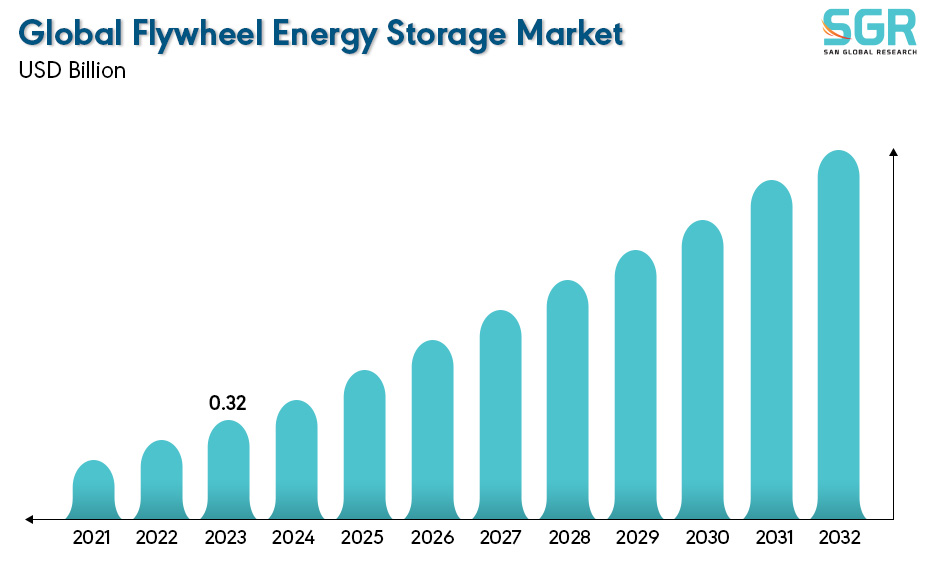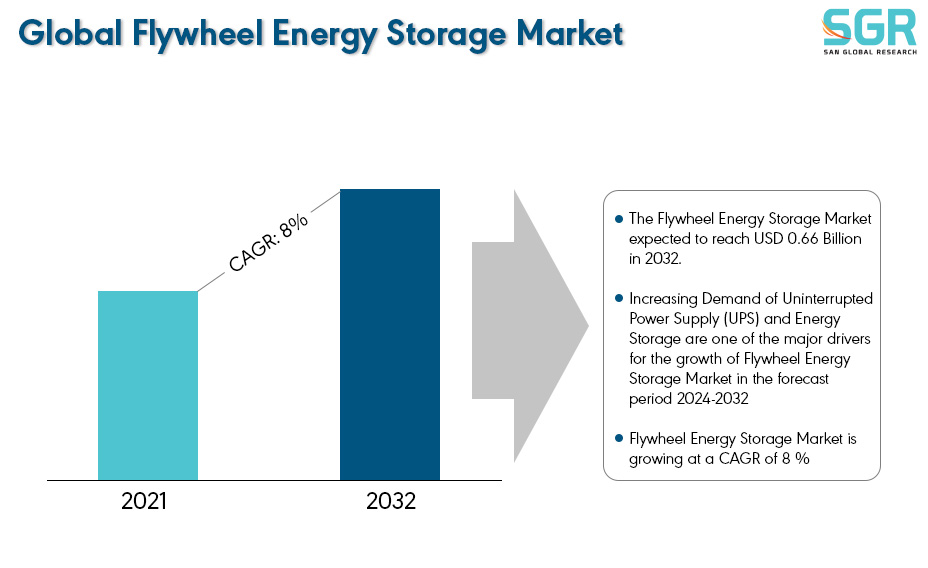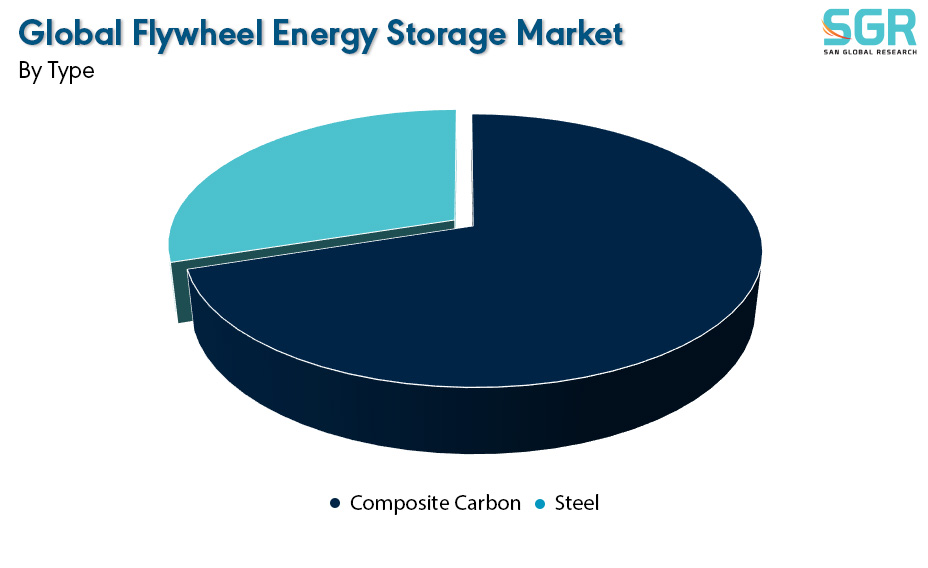Flywheel Energy Storage Market is estimated to be worth USD 0.32 Billion in 2023 and is projected to grow at a CAGR of 8 % between 2024 to 2032. The study has considered the base year as 2023, which estimates the market size of market and the forecast period is 2024 to 2032. The report analyzes and forecasts the market size, in terms of value (USD Billion), for the market. The report segments the market and forecasts it by Type, by Application and by region/country.

Flywheel energy storage represents a sophisticated approach to storing electricity in the form of kinetic energy. The concept involves using excess electricity to power a motor, which in turn spins a flywheel at thousands of revolutions per minute, thereby storing kinetic energy. The flywheel's movement is facilitated by its levitation within an evacuated chamber using magnets and highly efficient bearings. The stored kinetic energy, in the form of the flywheel's momentum, can later be used to drive an electricity generator within the system and produce power.
One of the primary advantages of flywheel systems is their low maintenance costs, coupled with an extended expected lifetime. Additionally, they offer fast response times and boast a roundtrip efficiency of approximately 90%.

Flywheel energy storage units (FESUs) offer significant advantages for renewable energy-based microgrids, providing immediate active power support. These advantages include high power density, efficient energy conversion, and a long lifespan. In recent decades, FESUs have found application in uninterruptible power supplies (UPS) where frequent short-duration power fluctuations can degrade battery life. Beyond microgrids, FESUs play a role in autonomous energy production for transportation and space applications. Here, they facilitate energy transfer and contribute to satellite stabilization and movement (gyroscopic effect).

After reviewing the data shown below, it can be determined that the North America region dominates the Flywheel Energy Storage Market for the following reasons.
Due to the increasing demand for clean and renewable energy storage solutions, the North American region has taken necessary steps to adopt Flywheel Energy Storage (FES). The rapid growth of renewable energy sources such as photovoltaic solar and wind generation is driving the need for cost-effective energy storage. This is essential for capturing energy during peak generation periods, enabling its use during peak demand periods. Existing solutions suffer from numerous drawbacks, including environmental impacts, safety hazards, declining capacity, high maintenance requirements, limited operating conditions, and grid management constraints. However, the kinetic energy storage system based on advanced flywheel technology is a promising alternative. It maintains full storage capacity throughout its lifecycle, produces no emissions, operates effectively in a wide range of environmental conditions, and is fully recyclable at the end of its life.
The Asia Pacific region emerges as a key market for Flywheel Energy Storage (FESS) as part of significant efforts to reduce carbon emissions. Under the important directive of General Secretary Xi Jinping to reach peak carbon dioxide emissions by 2030 and achieve carbon neutrality by 2060, several provinces in China have introduced new energy storage plans. These initiatives have led to the rapid proliferation of new energy and energy storage projects across the nation. By October 2021, China had surpassed 1 billion kilowatts in cumulative installed capacity for renewable energy power generation, representing 43.5% of the country's total installed power generation capacity. Future projections indicate sustained growth in new energy, with estimates suggesting wind and solar power installed capacity will exceed 1.2 billion kilowatts by 2030, surpassing coal power as the primary energy source. Both centralized and distributed new energy development initiatives rely heavily on energy storage technology, with FESS emerging as a pivotal component. FESS offers significant advantages including large capacity, high energy conversion rates, instantaneous power, and high-frequency charge and discharge capabilities. Flywheel energy storage systems (FESS) demonstrate broad applicability in several areas: grid frequency modulation, uninterrupted power supply (UPS), and kinetic energy recovery. Additionally, their nature as mechanical energy storage systems allow for seamless integration with new energy configurations.

By Type
Based on the Type, the Flywheel Energy Storage Market is bifurcated by Composite Carbon and Steel– where Composite is dominating and ahead in terms of share. The Composite Carbon type dominates the Flywheel Energy Storage segment due to various reasons such as superior strength to weight ratio because of the composite material used such as carbon fibre has incredible strength also being lighter than tradition steel due to which the composite translates to lower rotational inertia. This means less energy is wasted getting the flywheel up to speed and stopping it, leading to higher overall efficiency in the energy storage and retrieval process.

By Application
Based on the Application, the Flywheel Energy Storage Market is bifurcated by Distributed Energy Generation, Uninterrupted Power Supply, Transport, Data Centre and Others– where Composite is dominating and ahead in terms of share. With a rising global demand for Uninterrupted Power Supply (UPS), the Flywheel Energy Storage (FES) segment has emerged as a dominant force in the market. Unlike batteries, which may experience slight delays in response, FES units can provide immediate bursts of energy to bridge short power outages or voltage sags. This capability is crucial for maintaining the functionality of sensitive electronic equipment in environments such as data centres, hospitals, and industrial facilities. Additionally, FES offers a longer battery lifespan compared to traditional batteries.

Key Players
• Langley Holdings plc
• Amber Kinetics, Inc.
• Beacon Power
• Adaptive Balancing Power GmbH
• Energiestro
Drivers
Increasing Demand of Uninterrupted Power Supply (UPS) and Energy Storage
Energy storage systems (ESS) are revolutionizing our power grid by enabling cost savings through off-peak energy storage for peak use, improving power quality by mitigating fluctuations from renewable sources like solar and wind, and balancing supply and demand by adjusting power output in real-time. This translates to a more reliable and flexible electricity supply for consumers, even during grid failures where ESS acts as a backup using UPS technology. As a result, ESS paves the way for greater utilization of renewable energy sources, fostering a sustainable and dependable electricity grid.
Opportunity
Technological Advancements
Traditional mechanical bearings create significant energy losses due to friction, hindering the flywheel's ability to store kinetic energy. However, innovative magnetic bearings drastically reduce friction, enabling the system to achieve an impressive 97% mechanical efficiency. Furthermore, advancements in grid monitoring allow high-performance flywheel systems to respond with minimal delay to signals from grid operators. This real-time response translates to higher efficiency in energy storage by Flywheel Energy Storage Systems.
| Report Attribute | Details |
| Market Value in 2023 | 0.32 Billion |
| Forecast in 2032 | 0.66 Billion |
| CAGR | CAGR of 8% from 2024 to 2032 |
| Base Year of forecast | 2023 |
| Historical | 2019-2022 |
| Units | Revenue in USD Million and CAGR from 2024 to 2032 |
| Report Coverage | Revenue forecast, Industry outlook, Competitive Landscape, Growth Factors, and Trends |
| Segments Scope | By Type, By Application |
| Regions Covered | North America, Europe, Asia Pacific, SA and MEA |
| Key Companies profiled | • Langley Holdings plc • Amber Kinetics, Inc. • Beacon Power • Adaptive Balancing Power GmbH • Energiestro |

 Description
Description
 Table of Content
Table of Content
 Gera Imperium Rise,
Gera Imperium Rise,  +91 9209275355
+91 9209275355


